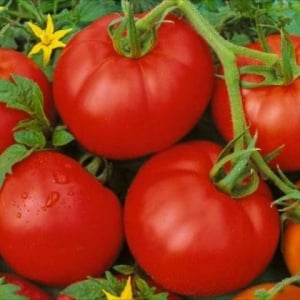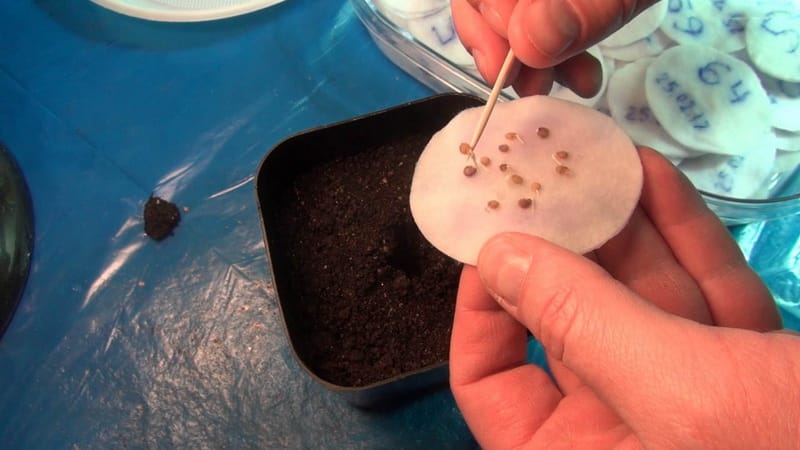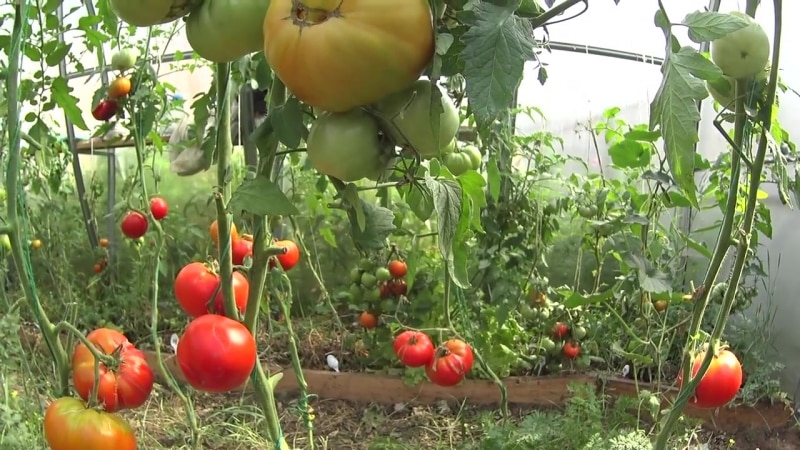What is good and why it is worth growing the early-ripening, high-yielding and disease- and weather-resistant tomato “Moskvich”
In the conditions of central Russia, the successful cultivation of many varieties of tomatoes in open ground is unlikely. This is hampered by short summers and frequent frosts. It is difficult for novice gardeners to get a good harvest without a greenhouse. Therefore, breeders have put a lot of effort into breeding crops that can cope with all negative external factors.
Thanks to the efforts of agronomists, the Moskvich tomato variety was developed. This culture is resistant to frost, temperature changes and is unpretentious in care.
Description of the Moskvich tomato

The Moskvich tomato was bred in 1976 by Russian breeders by crossing the Semena 373 and Nevsky varieties. And despite the fact that many other varieties of tomatoes have appeared during this time, this crop is still not considered obsolete.
The fruits are medium in size and red in color. The taste is sweet and sour, classic for tomatoes.
The variety was bred for cultivation in open ground in the extreme conditions of the northern regions. This is one of the few varieties that, withstanding low temperatures, produces a good harvest within three months after sowing the seeds.
Moskvich bushes are determinant. On average, the plant height reaches only 40 cm.
Advice! Due to its low growth, the Moskvich tomato is suitable for cultivation not only in a greenhouse and in open ground, but also on a balcony and on a windowsill.
Features of the variety
Moskvich tomatoes are a variety bred specifically for cultivation in the extreme conditions of the central zone of our country. The fruits of this crop are medium in size and uniformly red in color.
The taste of tomatoes is classic sweet and sour. The fruits are fleshy, with a small number of seeds. They contain up to 6% dry matter.
The main feature of the variety is frost resistance and ease of care. The tomato is not afraid of night frosts and is suitable even for the “lazy” gardeners.
Moskvich has immunity to a number of plant diseases. He is rarely struck late blight, which is considered one of the most dangerous tomato diseases.
Tomatoes are suitable for conservation, preparing tomato sauces, juices and hot dishes. Moskvich fruits can be used raw. Therefore, the variety is considered universal.
Characteristics of tomato
All characteristics of the Moskvich tomato correspond to the climatic realities of our country. This is one of the few varieties that can be grown in open ground in all regions of Russia.
Description of the variety:
| Parameter | Indicators |
| Bush type | Determinant. The maximum height of the bush is 50 cm. Standard. Medium leafy. The leaves are corrugated, small in size. The first inflorescence appears above the 8th leaf, the rest every 2 leaves. The growth of the bush stops after the formation of 3-4 brushes. |
| Growing method | Bred for cultivation in open ground and in unheated greenhouses. |
| Productivity | High. From one bush you can collect 2-3 kg of fruit. For one sq. m you can plant 6-8 bushes. Up to 7 fruits are formed on one brush. |
| Fruit | The tomatoes are bright red inside and out, possibly with a greenish spot at the base. The shape is round and regular, with slight ribbing at the base.The weight of one fruit varies between 60-80 g. Some specimens gain weight of 100 g. The taste is classic sweet and sour. Fleshy, dry matter content – 6%. The fruits have 5-6 chambers, with a small number of seeds. |
| Transportability | High. They have a tough skin. Thanks to it, tomatoes do not crack during transportation and in the heat. Can be stored for more than a month. |
| Ripening time | Early ripening variety. The first fruits ripen three months after sowing the seeds. Fruiting continues until autumn |
| Disease resistance | Fusarium wilt, tobacco mosaic, Alternaria. |
Growing seedlings
Sowing of planting material for seedlings is carried out 55-60 days before planting tomatoes in open ground. For the Moskvich variety, the optimal time for growing seedlings is the end or mid-March.
Preparing the seeds
Preparing the seeds will speed up and improve their germination. Therefore, this point must be taken seriously.
Preparation of planting material:
- Soak the planting material in salted water for 30 minutes. Remove any floating seeds. They won't rise.
- The seeds that have sunk to the bottom need to be washed and soaked for another 20 minutes in a light pink solution of potassium permanganate. This will disinfect them. Make sure that the potassium permanganate crystals are completely dissolved, otherwise they will burn the seeds.
- Place the seeds in a growth stimulator. To do this, soak pieces of gauze in the solution and wrap the seeds in them. This will speed up the germination of tomatoes.
- Dry the seeds after soaking. This can be done with a paper towel.
How to choose containers and soil
There are two options for sowing seeds. Each of them has its own advantages and disadvantages.
Seed sowing options:
- One large container.You can sow all the planting material in one large container - a special tray or box, cut-off juice boxes or a cake stand. In this case, after the plants have germinated, they will have to be planted in separate pots. The advantages of this method are its cost-effectiveness and ease of growing seedlings. The disadvantage is the need for early picking.
- Separate containers. You can sow the seeds directly into individual cups or peat tablets. In this case, they will not be replanted for a long time and will not injure the root system. The disadvantage of this method is its cost, especially when using peat tablets.
To plant plants, you can use not only store-bought pots, but also homemade containers made from plastic cups, cut-off bottles, etc. However, the container should not be too small.
To prepare the soil mixture yourself, take turf soil and humus in equal proportions. You can add one part of ash and one matchbox of soil fertilizers to the mixture.
The prepared soil must be disinfected. To do this, the earth is calcined in an oven at a temperature of 100 degrees or poured with boiling water.
Sowing planting material
When planting in a common container, grooves are made in the soil into which the seeds will be placed. They should have a depth of 1 cm, and be at a distance of 3 cm from each other.
The seeds are placed in the grooves at a distance of 2 cm from each other. They need to be sprinkled with earth on top.
The soil is well moistened with a spray bottle. To do this, use water at room temperature.
To create a greenhouse effect, the container is covered with glass or film and placed in a warm place. The temperature in it should be at least 25 degrees.
Water as the soil dries out. If the soil is too wet, remove the film and ventilate the plants. Otherwise, mold may develop.
Rules for caring for seedlings
In order for the seedlings to grow healthy and be ready for transplanting into open ground, you need to properly care for them. The list contains the basic rules.
Rules for growing seedlings:
- After the seeds germinate, the pot with seedlings should be moved to a well-lit place. If plants do not have enough light, use special lamps.
- The film can be removed when all the seeds have sprouted and the plants have become a little stronger.
- Water as the soil dries out. After seed germination, the soil must be moistened so that water does not get on the greenery of the plant. Use a pipette or syringe for watering.
- If the plants have turned yellow and have lost turgor, do not rush to water them intensively. The same symptoms occur with excessive soil moisture. Therefore, if the soil is wet, it needs to be dried a little.
- Picking tomatoes into separate containers is done after the first leaves appear on the seedlings.
- The first watering and fertilizing are carried out a week after picking. For this, complex fertilizers are used.
- Hardening of seedlings is carried out two weeks before planting them in the ground. To do this, the tomatoes are taken out into the fresh air in the warm part of the day, starting from 15-20 minutes and gradually increasing the time.
Growing tomatoes
Planting seedlings in open ground occurs when the soil warms up sufficiently. The ideal time is mid to late May.
The seedlings need to be prepared. To do this, all plants are watered abundantly.
Transplanting
Before planting tomatoes, you need to prepare the soil.To do this, each square meter of land must be sprinkled with 40 g of superphosphate, 15 g of dry chlorine and 20 g of ammonium nitrate and dug up.
The holes are dug in a checkerboard pattern. The distance between rows should be 60 cm, the distance between plants 30-40 cm.
The depth of the holes should be approximately 35 cm. When planting plants, their lower leaves are removed.
Tomatoes are planted in the holes along with a lump of earth that was in the pot. The depressions are filled with soil.
Plant care
Tomato Moskvich is unpretentious in care. Even a novice gardener can cope with its cultivation. It can even be grown in a country house that you visit once a week.
This variety does not need staking. The bush grows only 40-50 cm in height. But it is growing greatly in breadth.
It is also not necessary to plant a tomato. In the evening, it is enough to pick off yellowed and wilted leaves. The productivity of Moskvich is explained precisely by the large number of ovaries.
Water as the soil dries out. It is important not to overwater the plants.
Fertilizers are applied once a week. Tomatoes are fed organic and mineral compounds. You can use complex fertilizers. Foliar feeding should include boron.
What rules must be followed when growing tomatoes?
In order not to encounter difficulties when growing Moskvich tomatoes, follow some rules.
Tips for growing Moskvich:
- It is better to plant tomatoes not in the sunniest place, but in partial shade.
- You should not grow tomatoes in a place where other tomatoes or nightshades (potatoes, eggplants) grew last year. Such plants will feel best in the beds after cabbage, cucumbers and onions.
- If the bush has too many fruits and it leans toward the ground, it may need support or garter. It is important that the tomatoes do not lie on the ground.
- Watered bushes in the morning or evening. Water should be poured at the root without touching the greens of the tomatoes.
- It is important to weed tomatoes regularly, especially in the first weeks of transplanting them into open ground. Weeds can lead to the death of immature tomatoes and increase the risk of them becoming infected with diseases.
- Loosening the soil around tomatoes will improve air exchange in their root system.

Diseases and pests
The Moskvich tomato is not susceptible to many plant diseases. But for some diseases, tomatoes will still have to be treated.
Late blight occurs in conditions of excessive humidity. Muscovites rarely suffer from this disease. To prevent its development, you can use the “Barrier” product.
Dry spotting is caused by a fungus that attacks the plant at elevated temperatures. Treating tomatoes with copper preparations will help in the fight against this disease.
Necrosis of a tomato stem without timely treatment can lead to the death of the plant. To get rid of this problem, use “Fitolavin”.
Differences between growing tomatoes in open ground and in a greenhouse
Muscovite is grown mainly in open ground; greenhouses are used for more heat-loving and fastidious varieties. There are several rules that will help keep plants healthy in extreme conditions.
The first time after planting tomatoes in open ground, they need to be covered with film at night. This will protect them from night frosts. The greenhouse structure can be removed in early June.
Water in hot weather tomatoes are not allowed. Do this in the morning or evening.
Feedback from farmers suggests that Moskvich tomatoes grow better in open ground than in a greenhouse. In protected soil they grow in width and produce small fruits.
Harvesting
Moskvich is an early ripening variety. The first harvest is obtained in early July.
Pick the fruits as soon as they are ripe. Overripe tomatoes can cause tomato infection. You can also pick unripe fruits. They can also ripen at home.
Moskvich tomatoes are good fresh. But they are best suited for preservation. Their small size makes them easy to fit into any size jar.
Pros and cons of the variety
Moskvich has many advantages over other varieties of tomatoes. It is thanks to them that he has not yet lost his popularity.
Advantages of Moskvich tomatoes:
- ease of care;
- resistance to most plant diseases;
- excellent transportability;
- high productivity;
- early ripeness;
- frost resistance.
The disadvantages include the ordinary taste and small size of the tomatoes.
Farmer reviews
Reviews about the Moskvich tomato are contradictory. Residents of cold regions of Russia praise it more.
Farmer reviews:
Bloodless Maria, Arkhangelsk: «I have been growing Moskvich for several years now. This is one of the few tomatoes that can take root in open ground in our area. I use the fruits mainly for preservation. For fresh consumption, I grow tomatoes in a greenhouse.”
Kravets Oleg, Zelenograd: “On the advice of a friend, I tried the Moskvich tomato. An excellent variety for growing in the country. Unpretentious and needs minimal care. I can’t say that I really liked the taste of these tomatoes, but for canning it’s just the thing.”
Vasily, Udomlya village: “I’m a busy person, I work a lot. I can only go to the dacha on weekends. I want to grow my own tomatoes, but I don’t have time to bother with the garter and pick off the shoots. This year I sowed the old proven variety Moskvich. There is no need to cover it or reveal it. I fed it 3 times during the season, and the rain, of which there was a lot, watered the tomatoes for me. I thought that I wouldn’t wait for the harvest. But then the sun came out and the tomatoes began to sing together. In a word, I’m pleased with the variety.”
Conclusion
The Moskvich variety is one of the most unpretentious and frost-resistant tomatoes. It produces many small fruits within three months after sowing the seeds. It is not afraid of frost and rarely suffers from plant diseases.
This crop can be grown in the country, and it is suitable for even the most inexperienced gardeners. Even if you miss one watering of these tomatoes, it will not cause them to die.